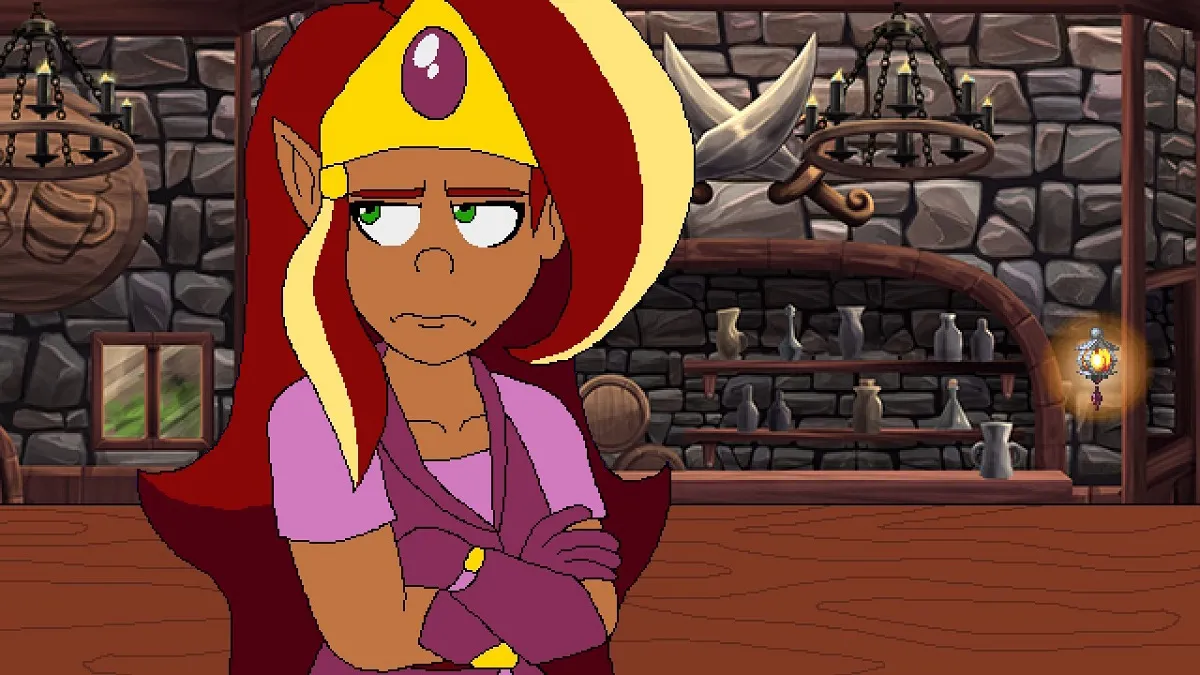It?s dangerous to base an entire game, movie, book, or anything on a single joke ? especially a referential joke. Yet the developers of Arzette: The Jewel of Faramore did exactly that.
The Phillips CD-i Legend of Zelda titles are many things, including a rare besmirchment on the brand and a laughing stock, but they?re rarely referred to as quality games. For some reason, Seedy Eye Software (oh, I just got that pun) chose those three games of questionable quality as inspiration. In particular, Arzette: The Jewel of Faramore is billed as a spiritual successor to Link: The Faces of Evil and Zelda: The Wand of Gamelon.
But if they were aiming for ?so bad it?s good? with Arzette, they?ve missed the mark entirely. Arzette is just plain good.
Screenshot by Destructoid
Arzette: The Jewel of Faramore (Switch [reviewed], Xbox Series X|S, PS4, PS5, PC)
Developer: Seedy Eye Software
Publisher: Limited Run Games
Released: February 14, 2024
MSRP: $19.99
The early steps into the world of optical media were, perhaps, the most awkward period of video games. While it was sometimes harnessed for good rather than evil with games that resembled the period?s normal fair with extra voices and cutscenes, others tried to stuff them full of terrible live-action cutscenes and FMV sequences barely resembling gameplay.
Nintendo nearly entered this market but bailed out at the last minute, leaving Sony, their first partner for an SNES CD-ROM attachment, scorned, and Phillips, the potential successor, with a license to make a few games with Nintendo?s properties. The result was Hotel Mario and three titles based on The Legend of Zelda.
You?ve probably heard of them since their internet fame propelled them to prominence. Both Link: The Faces of Evil and Zelda: The Wand of Gamelon had animated cutscenes that combined straight-to-video animation with nightmare fuel. Characters were questionably voiced and scripted, the transitions were strange, and while the animation had too-detailed movement, it had fewer frames than you?d expect. Every so often, an aspect of the games breaks away and once again enters meme-space. I even find myself unintentionally quoting the games.
Arzette: The Jewel of Faramore cops that style. It starts with a prologue narrated by a school marm before going into an impressive facsimile of CD-i Zelda?s uncomfortable animation. Seedy Eye went the distance with rough edges, horrible zooms, and stilted voice acting. Underlying this is a soundtrack made from extremely cheesy, low-quality sampling.
https://youtu.be/WF1FaM88M7g?feature=shared
The schtick progresses into the gameplay, where the world is broken into explorable, bite-sized stages. Hand-drawn backgrounds clash against basic collision and flat characters. Enemies warp away with cheesy sound effects. Bits of UI look both ostentatious and unpolished.
Arzette?s goal is twofold. She has to find the pieces of the eponymous Jewel of Faramore to defeat Daimur, the big evil. However, darkness is covering the land, so she must also light beacons to push it back and get access to more areas. Beyond that, she also needs to get items that allow her to proceed and become more powerful.
This isn?t much different from the earlier CD-i Zelda games, but the difference is that Arzette doesn?t suck. The controls are responsive, and the hit detection favors the player much better. More importantly, movement is much less sluggish. The levels are bigger and more open, which turns out to be a double-edged sword as you find yourself revisiting areas to plumb for secrets and find better gear. If you?re going for 100%, you?re going to be seeing the same level sections repeatedly.
I finished with around 98%, so it obviously didn?t bother me that much.
Screenshot by Destructoid
That?s largely because, while Arzette lifts heavily from a legendary kusoge, it?s more of an aesthetic than a crutch. The general framework of Faces of Evil and Wand of Gamelon are here, but some of the rougher edges (aside from the aesthetic) are polished down. It does its part to feel like the spiritual successor that it bills itself as.
Perhaps most strangely, Arzette never really makes a joke of itself. It certainly references the CD-i Zelda titles in a variety of ways, but it?s always subtle and dry. Weird stuff happened, but those games, in themselves, aren?t weird.
The jokes in Arzette are amusing on their own. The bizarre zooms and extravagant movements certainly add an extra layer of humor to its bad puns and subversiveness, but it isn?t just pointing and laughing. It knows how to be funny on its own, which carries it well beyond simple referential humor. It has heart and an affection to those titles. Rather than just poke fun at them, it takes what worked ? even if it was unintentional ? and expands on it.
Screenshot by Destructoid
The actual moment-to-moment gameplay is almost too simplistic for its own good. There isn?t much more to it than hopping around and smacking enemies. It does manage to capture the satisfying feeling one gets when they find an important item in a gated exploration game that gives you access to all those things that were previously held just out of reach.
On the other hand, that?s the cheapest part of Metroidvania games, and I?ve never felt comfortable when a game leans on that sort of easy thrill. It is, however, what Faces of Evil and Wand of Gamelon did, and expunging it would be abandoning part of its faithfulness. It fits the manifesto, so I can live with it.
Speaking of which, the publisher, Limited Run Games, created a USB reproduction of the CD-i controller specifically for this game. They sent me one, however it didn?t arrive on time, so I?ll tell you about it later.
Screenshot by Destructoid
I constantly found myself shocked at the passion that Arzette: The Jewel of Faramore demonstrates toward its source material. It would have been so easy to create a low-effort duplication of the CD-i Zelda games, but instead, Seedy Eye created a game that is enjoyable beyond just the references it makes. The music and animation, despite being stilted to emulate the CD-i aesthetic, are well done. The characters, while often analogous to the weirdos from CD-i Zelda, are memorable and interesting. More importantly, its sense of humor manages to tickle in the right places.
My only complaint ? and it is a minor one ? is that the gameplay is a bit on the basic side, being more important in the way it ties together the enjoyable cutscenes. At around 4-5 hours for a completion run, it doesn?t overstay its welcome.
Arzette: The Jewel of Faramore is such an unjudgmental love letter to Link: The Faces of Evil and Zelda: The Wand of Gamelon. It?s a reminder that whether or not a game is good or bad isn?t the whole store. It?s more complex than that. The internet found legitimate entertainment in the CD-i Zelda games, and rather than write them off as ridiculous, Seedy Eye dug in and asked why. It found what was so compelling about those astounding failures and applied those lessons in a thoughtful and deliberate way. The result transcends its influences and takes on a life of its own.
[This review is based on a retail build of the game provided by the publisher.]
The post Review: Arzette: The Jewel of Faramore appeared first on Destructoid.
More...
Results 1 to 1 of 1
-
02-14-2024, 09:48 AM #1
Review: Arzette: The Jewel of Faramore





 Reply With Quote
Reply With Quote